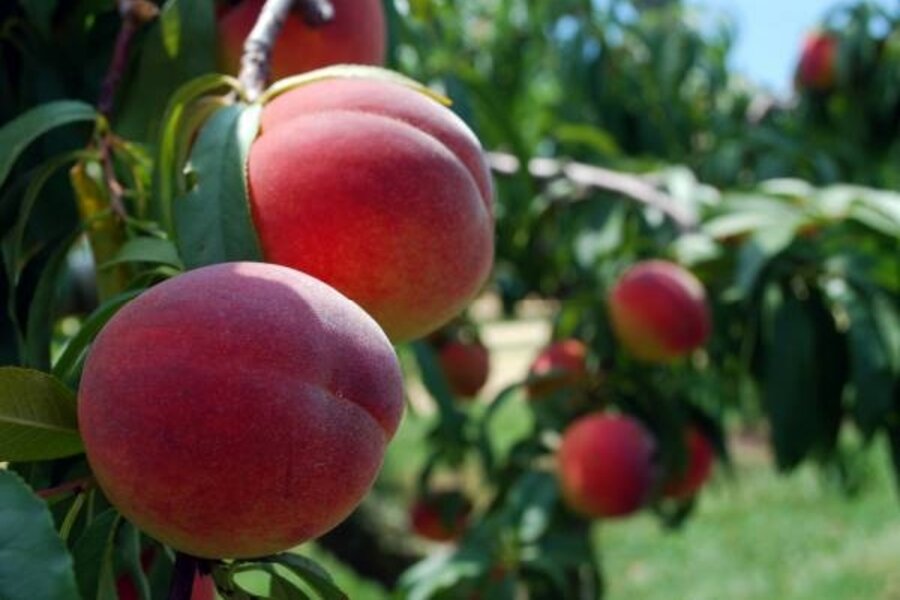Sweet, juicy peaches within your reach
Loading...
Frank Gouin examines a peach tree branch laden with red, fuzzy fruit, tests one for ripeness and twists it off. Soon peach juice is running down my chin. This orange-fleshed variety, Ernie's Choice, is meaty, sweet, and the freshest peach I've tasted.
Peaches are as much an iconic fruit of high summer as the tomato; indeed, in 18th-century America it was a far more popular treat. Peach trees, originally from China but brought to the New World by Europeans, became so prolific, both in orchards and in the wild, that even the great botanist John Bartram "assumed the peach was a native tree," writes Peter Hatch in his book "The Fruits and Fruit Trees of Monticello" (University of Virginia Press, 1998).
As with a lot of plants grown to excess, pests and diseases moved in, and by the early 19th century peach farmers in Virginia were, as Hatch notes, battling a deadly virus named peach yellows and two insects, the plum curculio and the peach tree borer. These pests are still around and make the prospect of raising peach trees at home a challenge, even for dedicated gardeners.
In 1995, Gouin retired as head of the horticulture department at the University of Maryland to grow peaches (and Christmas trees) on his 11-acre farm in Anne Arundel County, Md. "I'm having a ball," he says, meaning he goes to a lot of effort to raise luscious peaches. His 132 peach and nectarine trees produce about 200 bushels of fruit each summer, starting with Sentry and the Garnet Beauty varieties in early July and ending with the late-season Redskin in mid-August.
There are three aspects of peach cultivation that discourage casual growers, he says: pruning, thinning, and spraying. But if you commit to them, perfect peaches can be within your reach.
Late-winter pruning
Peach trees fruit on wood that grows the previous year, but they must be pruned in late winter to keep them healthy and productive. Gouin removes any new growth that is shorter than 12 inches. He trims longer stems back to 18 inches. He also removes wayward or unneeded stems that might erupt from the branches. There goes his March.
Thinning blooms and fruit
A little later, when the pretty blossoms appear, Gouin is out there with a toilet brush on a stick. A branch might have three ranks of blossoms, and he simply rubs out the top row with the brush when the flowers are at "popcorn stage" — just about to open fully.
Both the pruning and thinning reduce the fruit set, and without those steps the trees will produce hundreds of congested fruits about the size of a golf ball. When the fruits begin to form, Gouin goes back and removes them by hand to leave desired fruit four to six inches apart on the branches. "No one wants a peach less than 2 1/2 inches" in diameter, he says.
Fighting disease and bugs
Spraying is the most unsettling, but necessary, aspect of peach cultivation. After a wet spring, "I have got 12 sprays on these trees," Gouin says. He spent much of his career researching the benefits of compost, which is the pillar of organic growing, but he says it is impossible to raise pristine peaches organically in the wet and humid Eastern United States. Among the more damaging fungal diseases are peach leaf curl, which causes disfigured leaves and leaf drop in early spring, and brown rot, which ruins the ripening fruit.
In addition to the borer and the curculio, an insect called a stink bug causes fruit to deform.
Some authorities suggest that organic sulfur spray might control fungal diseases. Gouin says that it saves about half the fruit, but the grower will have to remove others that develop brown rot to prevent the spread of the spores and disease.
The classic "How to Grow Vegetables and Fruits by the Organic Method" by Rodale says this about preventing brown rot: In early spring, examine the tree "for the telltale gray tufts on the twigs which will produce the fungus spores. Remove all the infected twigs before the blossoms are in bud."
As for the curculio, a weevil that appears just as the flowers are blooming and is present through May, Rodale suggests this approach: Each morning during this six-week period, put a tarp under the tree and give the trunk a few blows. The pests will drop to the tarp, where they can be squashed. Perhaps you can tap the trunk with your toilet brush; just don't let the neighbors see you.
Fruit tree alternatives
Given the demands of Prunus persica, it might be easier to forgo cultivating the plant and just buy some peaches at the supermarket. But there are pitfalls there, too. Horticulturists know the peach as a fruit that will not ripen off the tree. If it is picked with its yellow skin in the green stage, it will ship well but never fully mature.
Gouin says that if you are looking for easier tree fruits to grow, go with varieties of Asian pear, Asian persimmon, or pawpaws. But if you do decide to plant a little peach orchard, you may want to follow Gouin's example of soil amendment. He applied six cubic yards of finished compost per 1,000 square feet.
"We had peaches the second year after planting," he says. The trees themselves "took off like scared rabbits."
Editor’s note: For more on gardening, see the Monitor’s main gardening page. Our blog archive. Our RSS feed.
You may also want to visit Gardening With the Monitor on Flickr. If you join the group (it’s free), you can upload your garden photos — and possibly win a prize. Deadline is Aug. 11. Join the discussions and get answers to your gardening questions.





